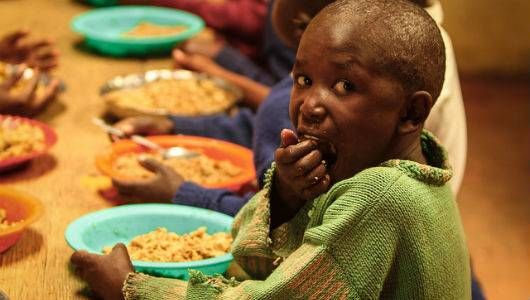
By Francis Kokutse
African countries need to wake up to the call by the World Health Organisation (WHO) that something needs to be done to improve the nutrition of children and reduce the incidence of stunted growth. This is important because research has linked poor nutrition to unfavourable academic work. Therefore, if African children must not be caught in the web of poor nutrition that will affect their growth in every aspect of life, some changes must be put in place.
The report by the WHO said, “under-nutrition is still persistent in the region and the number of stunted children has increased.” It also said a growing number of children under five years old are overweight, which is against the targets member states have committed themselves to achieve by 2025.
“The nutrition targets call for a 40 percent reduction in the number of children under-five who are stunted, 50 percent reduction of anaemia in women of reproductive age, 30 percent reduction in low birth weight, no increase in childhood overweight, increasing the rate of exclusive breastfeeding to at least 50 percent and reducing wasting to less than 5 per cent,” the WHO said.
Reacting to the findings, WHO Regional Director for Africa Dr Matshidiso Moeti, said “the numbers and trends highlighted in the report show that we need to work harder to avoid the long-term consequences of malnutrition and poor health on our children’s future prosperity, including the increased risk of diet-related non-communicable diseases such as diabetes and hypertension.”
The Report points out that while the prevalence of stunting decreased between 2000 and 2016, the absolute numbers of stunted children are in fact increasing: from 50.4 million in 2000 to 58.5 million in 2016. Stunting, or impaired growth and development happens when children experience poor nutrition, disease and lack of psychosocial stimulation.
It said, this typically occurs before a child reaches the age of two, and the long-term consequences include poor school performance, low adult wages, lost productivity and increased risk of nutrition-related chronic diseases in adults.
Lead author of the Report, Dr. Adelheid Onyango, who is WHO Africa’s Adviser for Nutrition, says while overweight rates in children might still be low, the proportion and numbers are increasing in all age groups. Among adults for example, overweight, including obesity, affects about one in three women, with rates of over 40 percent in Gabon, Ghana and Lesotho.
Joint UNICEF, WHO and World Bank 2016 estimates show that the number of overweight children in Africa increased by more than 50 per cent between 2000 and 2015. The Report found that 24 countries have rates between 3 and 10 per cent; above this range are Algeria (12.4 per cent), Botswana (11.2 per cent), Comoros (10.9 percent), Seychelles (10.2 per cent), and South Africa (10.9 per cent).
Director of the Nutrition Department at the WHO Headquarters in Geneva Francesco Branca said, “African Governments can, and should, take measures to prevent and reduce under-nutrition by creating favourable environments for improved infant and young child feeding, improved water supplies and sanitation, and offering healthier foods in schools among other measures.”
Branca emphasized the need to reduce consumption of refined carbohydrates and foods high in sugars and fat, which can be achieved by making sugary drinks less affordable and less appealing through taxation, labelling, and changing marketing practices.
It looks like Nigeria has taken the lead with the launch of a National Council on Nutrition with the country’s Vice-President Yemi Osinbajo saying, the country must make speedy and visible progress in its fight against hunger, malnutrition and other nutritional challenges.
He said if the policy was fully implemented, it will ensure significant improvements in several specific national indices, including the reduction of stunting in under-5 children, reduction of wasting in children, reduction of anaemia in pregnant women, reduction in adult obesity rates, and an increase in the rates of exclusive breastfeeding.
Vice-President Osinbajo said, there is a clear connection between nutrition and economic growth, adding that, “If we invest in improved nutrition for our people we will see the results not only in improved emotional and psychological satisfaction in our citizens, but also in reduced healthcare costs and increased economic productivity.”
In Ghana, it looks like we are only paying lip-service to nutrition in children at the national level. Nestlé seems to be taking the initiative on improving nutrition among children by improving its foods and beverages for children by assessing them against the Nutritional Profiling System (NNPS) criteria to determine their Nutritional Foundation (NF) status.
The company said, it is doing this by ensuring that, its “products are both nutritious and tasty”. Whatever they are doing seems to be challenging, and yet, through tailored innovations, careful monitoring and action plans, adding that, the company can now claim that, “95 per cent of our foods and beverages for children met all the NNPS criteria, and therefore reached NF status, by the end of 2016.”
Nestlé has stated its objective towards 2020 as ensuring that, in both developed and developing countries, design and launch foods and beverages that address the daily nutritional needs and key nutritional gaps of infants, children up to age 12, new mothers and mothers-to-be.
It said, an estimated 2 billion people – over 30 per cent of the world’s population – suffer from deficiencies in essential vitamins and minerals, especially the ‘Big 4’: iron, iodine, vitamin A and zinc. “Micronutrient deficiencies disproportionately affect infants, young children and women, preventing them from achieving their full potential in life,” the company said, adding that, “the consequences of this can be devastating, leading to mental impairment, poor health, low productivity and, in severe cases, death. Even mild to moderate deficiencies can affect a person’s well-being and development.”
For this reason, the company said, ideally, these nutrients should come from a balanced, varied diet but this is not always possible, particularly in developing countries. It has therefore taken the responsibility, as well as an opportunity, to improve the nutrition status of people at risk by adding relevant micro-nutrients to foods and beverages consumed regularly by vulnerable populations.
Nestlé is also investing in Bio-fortification which the company said, “can also make crops more nutritious by selecting and breeding plant varieties that are naturally rich in micro-nutrients. It can contribute to the nutrient density of diets that are based mostly on staple foods and for those people who may not have access to fortified processed foods.” .
It has also started work with agricultural research institutes through its HarvestPlus programme, to develop and establish supply chains for bio-fortified crops. “In Nigeria, we are blending pro‑vitamin A bio-fortified maize with normal maize, and reserved more than 1000 tonnes of grain in 2016 for use in our branded cereal porridge.”
Nestlé said its Research and Development Centre in Abidjan, Côte d’Ivoire, is also exploring opportunities in bio-fortified cassava, wheat, rice and maize with partners in Madagascar, Turkey, Brazil and India. This is geared towards their 2020 objective to reach millions of children and families with fortified foods and beverages, initiate collective actions to reduce micro-nutrient deficiencies in 10 countries as well as continue to develop the supply chain for bio-fortified crops and expand the company’s fortified portfolio.























